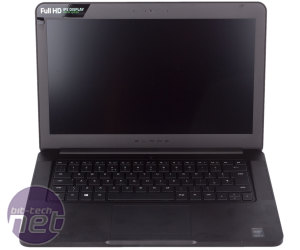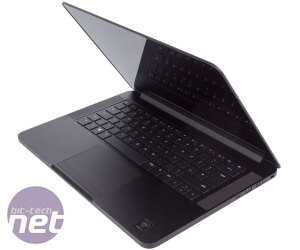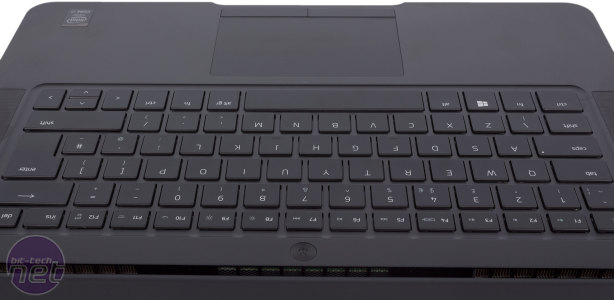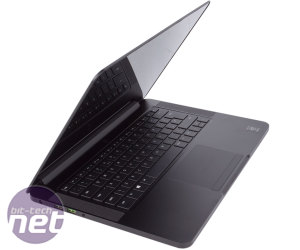
Performance Analysis
As far as gaming goes, the Razer Blade is pretty powerful. Even with ultra settings enabled, it pumps out smooth frame rates at 1080p, with minimums of 37fps and 47fps in Battlefield 1 and Fallout 4 respectively. It also justifies Razer's VR-capable claims by passing the VRMark Orange Room test, signifying that it meets the requirements of the Oculus Rift and HTC Vive headsets – this is rather impressive given the Blade's dimensions and weight. As suspected, 3,200 x 1,800 is beyond this GPU's capabilities, at least with the settings cranked up.That said, there's more to note about the results. The headline story behind Nvidia's latest iteration of mobile GPUs is that they were essentially as fast as their desktop counterparts – Nvidia even dropped the -M suffix from the naming scheme to signify this. However, a laptop is still a heavily power-limited environment and this does have repercussions. On the GPU, this means less consistent boosting, so don't expect desktop-matching performance. We haven't included results from a desktop GTX 1060 card in the charts, but the Fallout 4 average frame rate and all of the 3DMark results are roughly 20 quicker when you have a Founders Edition GTX 1060 in a desktop environment. Honestly, that's still not a bad thing, and not to Razer's discredit, but it's worth noting nonetheless.


Click to enlarge - The Blade with the Full HD matt display (left) and with the QHD+ glossy touch display (right)
The exception to this is Battlefield 1, where the average frame rate is almost 50 percent faster on the desktop equivalent. This suggests a limit beyond the GPU, the obvious candidate being the CPU, especially as this is a DirectX 12 game. Despite its four cores and Hyper-Threading, the Core i7-6700HQ can't compete with an overclocked Core i7-6700K (understandably). Thankfully, the laptop is still playable at 1080p, and there's nothing to suggest other GTX 1060-equipped laptops would fare much better – the PC Specialist Defiance III has a very similar result to this one in Fallout 4, for example.
Moving beyond gaming, the Blade is a well-rounded laptop for everyday and even more intensive tasks. The PCMark 8 results weren't astounding but nor were they cause for concern, and the Hyper-Threaded quad-core CPU makes a really good go of rendering given that it's a mobile part. The speedy SSD also saw strong performance in synthetic and trace-based workloads – it'll be responsive and fast regardless of what you throw at it.
Battery life also proved to be a real strong point – nearly five and a half hours in the light test and nearly 90 minutes in the gaming test. These are great results, and comfortably beyond competing laptops in both instances.
Display performance was a bit disappointing on the glossy QHD+ model, especially after the strong results we saw on the Razer Blade Stealth. The screen has a wide brightness range, but the measured contrast ratio was never more than 400:1. To our eyes, it didn't seem quite that bad, but contrast definitely felt a bit lacking in certain test photos, and it was definitely improved on the matt 1080p panel which measured at between 600:1 and 700:1. Luminance uniformity was good, but honestly your biggest challenge here is going to be ambient light – if you've got bright lights behind you they'll reflect harshly off the glossy surface. While the white point was close to the ideal, the gamma measurement was low, giving some scenes a slightly washed out feel (not extreme, not noticeable), and colour accuracy was only okay too – an average delta E of less than 3 is preferred, but here we see 3.87.
Meanwhile, the 1080p panel fairs well and is the better option overall. Gamut coverage is its main weakness as it only hits 92 percent of the sRGB spectrum, but otherwise the results are strong. We see an ideal gamma value, close to ideal white point and excellent uniformity. Colours are also closer to what they should be with this panel, with an average delta E value of 2.25 being a very strong result. Given this, the QHD+ screen doesn't make the best case for itself as a £300 upgrade beyond the increased pixel density and touch functionality, though we admit that those things may have a lot of value for some users.
The laptop's cooling system proved to be very effective. Applying full load to the CPU, we didn't observe any throttling and noise levels were well contained. The GPU is more demanding, and while its clock speeds did fluctuate more than we're used to seeing on desktop cards, it was still boosting to high speeds (over 1,800MHz) with some frequency. Noise output was higher this time around, but still not obnoxious – we probably wouldn't feel too bad playing on a train, for example, unless we were in the quiet carriage. Both the CPU and GPU were kept below 80°C too.
Conclusion
The physical design of the Blade easily stands out as its most valuable asset. The premium chassis really looks and feels the part and this can go a really long way in this market. The sub-2kg weight and sub-20mm thickness also make it very portable considering the power it houses, and the Chroma RGB keyboard and trackpad both impress too. Even the internals are solid – Razer has left room for a large battery that has a good impact on potential battery life, you get easy access to the M.2 SSD and the cooling system is capable of keeping things cool and unthrottled without being too loud.Razer sent us the top-spec Blade, but we don't believe this is its best representation. Firstly, the screen – the high PPI and touch functionality may well be of use to some folk, but Razer's pitch is traditionally towards gamers, and the GTX 1060 isn't able to dish out suitable frame rates at the native resolution when using this panel. Also, the professional users more likely to be enamoured by the high resolution screen probably wouldn't be overly impressed with its performance. We also found the glossiness to be an issue again. As such, the 1080p panel seems like the best choice on most fronts (and it saves you £300) – it's a shame neither panel has G-Sync, but we don't think Razer had a choice here. If this QHD+ screen blew us away with quality, we could get behind the upgrade, expensive though it is – this is a premium product after all. However, beyond the exceptional clarity it doesn't really do this.
Then there's the storage. Having 1TB of ultra-fast NVMe SSD storage is certainly awesome, as that'll allow you to cram many a game on there without worrying. However, the price Razer has set for this is almost insulting. Moving from the 512GB configuration to the 1TB one will cost you £400 regardless of which panel you choose, or £600 coming from the 256GB one. The SSD Razer uses, the PM961, is readily available for less than £400 – you could buy the 256GB laptop, then buy the PM961 1TB and upgrade the laptop yourself, and have a 256GB M.2 SSD and nearly £250 left over compared to what you'd have paid buying direct from Razer. Sure, not everyone will want to tinker with their laptop's insides, but the fee for avoiding this is astonishingly high. Companies like Apple and Dell do have similarly extortionate storage upgrade fees, but we're not sure that's an excuse.
The overly expensive storage is relatively easy for us to overlook, since we can just suggest you buy the better value, lower capacity models instead. However, the glossy QHD+ screen is a sticking point in just a few too many places for us to recommend this model of the Razer Blade for the price it demands. As such, the award below applies only to the sub-£2,000 1080p models. For those looking for a premium gaming laptop that's portable, powerful and sexy, these models tick all three boxes without tipping the pricing from expensive to absurd.


MSI MPG Velox 100R Chassis Review
October 14 2021 | 15:04












Want to comment? Please log in.